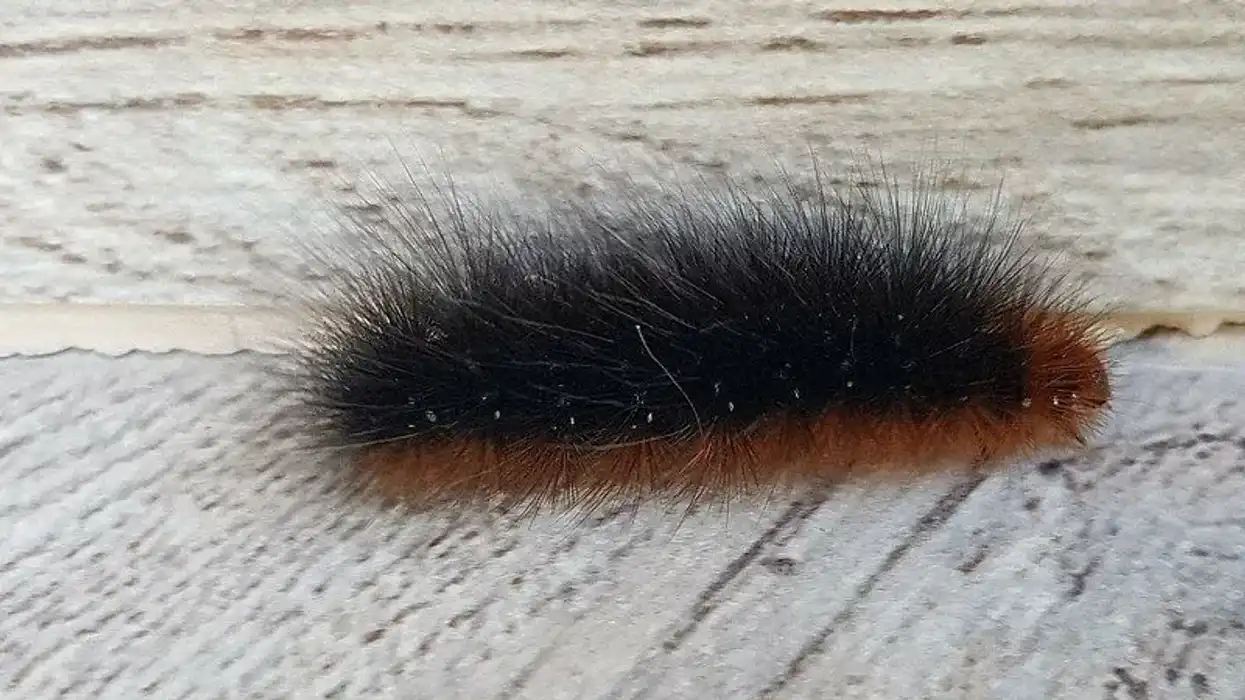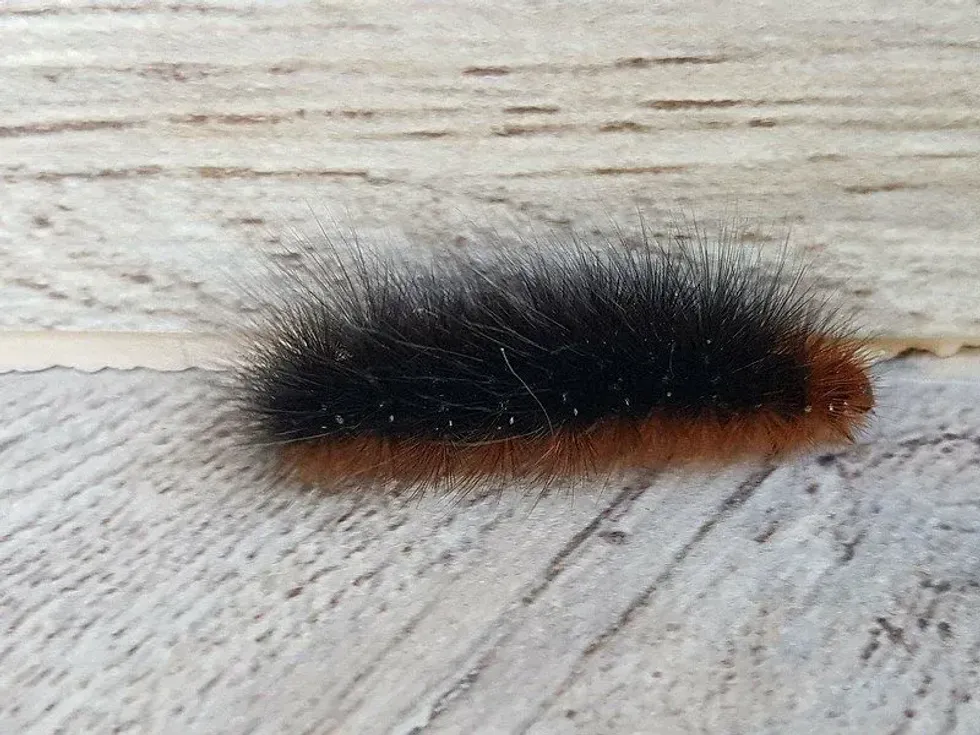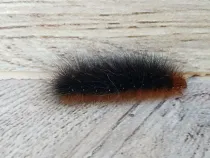Fun Arctic Caterpillar Facts For Kids

If you want to learn and know about a unique caterpillar that freezes itself to survive winter, then you must read about the Arctic woolly bear caterpillar. These caterpillars have the unique adaptation of freezing themselves to survive in the winter months.
Before the winter arrives, the species feed themselves on whatever little vegetation is available on the three to four weeks long summer in the Arctic. As temperatures start dropping in the region with the arrival of winter, the caterpillar freezes.
They only survive by breaking down the glycerol in their cells which acts as an anti-freeze agent for the caterpillar.
Again, as the summer arrives, the caterpillar emerges to feed on the vegetation. This goes on for a period of seven years before the caterpillar changes into the moth.
So, scroll down to learn more about this interesting caterpillar. For information on some other caterpillar types, take a look at saddleback caterpillar facts and fiery searcher caterpillar hunter facts.
Arctic Caterpillar Interesting Facts
What type of animal is an Arctic caterpillar?
An Arctic woolly bear caterpillar (Gynaephora groenlandica) is the larvae stage in which the Arctic woolly bear moth spends almost 90% of its life.
With special adaptations that help them survive temperatures as low as -90 F (-32.2 C) in the High Arctic regions, Arctic woolly bear caterpillars are thought to be one of the most unique creatures on this planet.
What class of animal does an Arctic caterpillar belong to?
Gynaephora groenlandica, Arctic woolly bear caterpillars, are the larval forms of adult Arctic woolly bear moths. Thus, they belong to the class of insects, Insecta. They are part of the Erebidae family of moths and the genus Gynaephora.
How many Arctic caterpillars are there in the world?
Living and surviving in the frozen winters of the Arctic, the total population of the Arctic woolly bear caterpillar is extremely difficult to calculate. Firstly, it can be tedious to keep a tab on these rare creatures in their larvae stage, and secondly, the caterpillar lives for a small amount of time when they mature into adult moths.
There have only been a few sightings of an adult Arctic woolly bear moth. As such, getting an exact number of individuals in this species is difficult.
Where does an Arctic caterpillar live?
As is evident from their name, the Arctic caterpillar lives in the freezing far north of the Arctic regions. They are found in places in Northern Canada.
In Canada, this woolly bear caterpillar has been observed in regions like Ellesmere Island and Ward Hunt Island. In recent years, new subspecies of these caterpillars have been discovered in the Canadian province of Yukon.
Another subspecies has also been found in Russia, occurring solely on Wrangel Island. Apart from these places, the Arctic woolly bear caterpillar lives in the cold weather conditions of Greenland.
What is an Arctic caterpillar's habitat?
The Arctic woolly bear caterpillar usually lives within specific microhabitats, as opposed to regions with specific habitats. During the time they are frozen during the winter, the Arctic woolly bear caterpillar usually lives near rock bases.
The probable cause for this behavior has been attributed to the fact that the rocks get dethawed faster than vegetation giving the caterpillars a head start into moving around and looking for food. However, sometimes, when in captivity, they have been seen attaching themselves to vegetation to be frozen for the winter.
In the last few years, scientists have also suggested the fact that wind may play a role in how the caterpillar will choose a spot to overwinter during its life span. To avoid the freezing winds of the high north, the caterpillar will search for its hibernation spot on the leeward side of the rocks, protected from the wind.
Who do Arctic caterpillars live with?
The life history of the Arctic woolly bear caterpillar suggests that they are primarily solitary animals. These caterpillars go through their hibernation period frozen in ice all alone.
As the years pass and the caterpillar matures into an adult moth, only then does it look for a mate to reproduce. In fact, once the egg cluster is laid in the cocoon of the female, the larvae grow up on their own and have to start looking for food the moment they are born.
How long does an Arctic caterpillar live?
Given the title of the world's oldest caterpillar, the Arctic woolly bear caterpillar has a long life span that lasts 7-14 years. Usually, it takes around seven years for the caterpillar to develop into a full-grown moth; however, in places that lack proper vegetation, the Arctic woolly bear caterpillar may live up to 14 years.
Interestingly, the final life stage of the caterpillar turning into a moth is very short.
In fact, adult moths have to mate within a few weeks of maturation. As soon as mating and reproduction are complete, the moths die.
How do they reproduce?
With the Arctic woolly bear caterpillar going through the repeated process of being frozen, again and again, they can only reproduce once they are in the moth stage of their life cycle. And even went they reach that stage, they do not have the adaptations to live long.
So, they have to look for a mate immediately to start breeding while they are alive.
Interestingly, males of this species are the only ones with the ability to fly while females cannot. Once the mating is complete, the female lays an egg cluster protected within her cocoon.
This usual process of breeding usually takes place in the short summer months of the Arctic, especially in the months of June. The eggs will hatch in the fall months and the caterpillar starts feeding on emergence before being frozen to survive the cold conditions.
What is their conservation status?
Unfortunately, none of the conservation organizations have conducted evaluations for the Arctic woolly bear caterpillar. Yet, it goes without saying that these caterpillars and their Arctic woolly bear moth forms are quite difficult to spot and we can assume that their population is not very high.
On top of that, there are a few predators of this species that hunt the eggs and the caterpillars themselves.
Arctic Caterpillar Fun Facts
What does an Arctic caterpillar look like?
 *Please note that this is an image of a large blue butterfly caterpillar. If you have an image of the Arctic caterpillar, please let us know at hello@kidadl.com!
*Please note that this is an image of a large blue butterfly caterpillar. If you have an image of the Arctic caterpillar, please let us know at hello@kidadl.com!The Arctic woolly bear caterpillar is known for its woolly looks. There are certain adaptations that have evolved in them from years of living in the cold winter conditions of the Arctic.
The first thing that you notice while observing the caterpillar is its woolly appearance. The soft hairs on its body are densely distributed and this helps the caterpillar conserve heat which they receive when they are basking in the sun in order to feed on dethawed vegetation.
The coloration of these hairs is usually tan and brown but these colors may vary to a certain degree.
Interestingly, the eight abdomen segment of the caterpillar has tufted hair which is distinguishable from others. Unlike the normal woolly bear caterpillar, these caterpillars do not have bands, like the orange band, with different colorations on them.
This woolly bear moth is gray in coloration with no bands on its wings. This helps them to be separated from another species in its genus called the Ross' tussock moth.
How cute are they?
This unique caterpillar can be adorable and cute for many people. Its woolly appearance along with its special moth form adds to its beauty.
Many are also awestruck by the fact that these tiny creatures have the ability to endure through the cold winters of the areas surrounding the North Pole. Many documentaries have been made on these special creatures which highlight the adaptations they have to stay frozen in the extremely cold winter months.
How do they communicate?
Communication modes between caterpillars is a field of study that has given us inconclusive results in the past. In the case of the frozen woolly bear caterpillar, the amount of study and research conducted on their communication tactics are even less.
As such, we can only presume that these caterpillars can communicate with others through certain auditory and sensory signals.
However, the one thing we do know about these caterpillar-turned-moths is the fact that they have can detect bat signals and change their course accordingly. This ability helps them evade predators. They can detect these signals from a distance of around 50-82 ft (15.2-25 m) away.
How big is an Arctic caterpillar?
The woolly bear caterpillar is quite small. While they can be anywhere between 1-2 in (2.5-5 cm), they are pretty similar to other caterpillars in their genus, like Ross's tussock moth.
How fast can an Arctic caterpillar fly?
A caterpillar cannot fly. It is only when the caterpillar becomes a moth does the question of flight speed comes into the equation. For the Arctic woolly bear moth, only the males are known to fly while females are immobile. Males can fly around quite fast and erratically in search of a suitable mate to breed with!
How much does an Arctic caterpillar weigh?
The weight of the Arctic woolly bear caterpillar is estimated to be around 0.0105 oz (297.6 mg).
What are the male and female names of the species?
There is no such distinct name for a male and female caterpillar. It can even be very difficult to differentiate between a male and female caterpillar.
What would you call a baby Arctic caterpillar?
Since a caterpillar is the first stage after the eggs hatch, the only way to refer to a baby Arctic woolly bear caterpillar is by calling them a young Arctic caterpillar.
What do they eat?
Being herbivores, this caterpillar is known for feeding on the little vegetation that is available to them before winter strikes. They feed on plants like the Arctic willow, wideleaf polargrass, alpine bilberry, alpine fescue, and other vegetation.
Their feeding habits show us that they feed on plants to gain nutrients and carbohydrates to help prepare themselves to freeze through the winter.
Are they dangerous?
No, the Arctic woolly bear caterpillar is not dangerous.
Would they make a good pet?
As they are suited to a certain cold temperature and habitat, we recommend not keeping this species of caterpillar as a pet.
Did you know...
A female Arctic woolly bear caterpillar does not have the ability to detect bat signals.
The eggs of the Arctic woolly bear caterpillar have been observed to be around 0.06 in (1.5 mm) in size.
The cocoon of this species of caterpillar has two layers of silk and protection around. This is in contrast to the one layer of protection that most cocoons have. Still, the eggs that are laid in the cocoon and the moths themselves are preyed on by bats and snow buntings.
Are there caterpillars in Antarctica?
No, there have been no reports of caterpillars being found in Antarctica.
What is the longest living caterpillar?
The Arctic woolly bear caterpillar is thought to be the longest living caterpillar in the world with its life cycle spanning seven years on average.
Here at Kidadl, we have carefully created lots of interesting family-friendly animal facts for everyone to discover! For more relatable content, check out these stick bug facts and Christmas beetle facts for kids.
You can even occupy yourself at home by coloring in one of our free printable bug coloring pages.
*Please note that the main image is of a garden tiger moth caterpillar. If you have an image of the Arctic caterpillar, please let us know at hello@kidadl.com!
We Want Your Photos!
More for You
Bachelor of Arts specializing in Journalism and Mass Communication, Postgraduate Diploma in Sports Management

Moumita DuttaBachelor of Arts specializing in Journalism and Mass Communication, Postgraduate Diploma in Sports Management
A content writer and editor with a passion for sports, Moumita has honed her skills in producing compelling match reports and stories about sporting heroes. She holds a degree in Journalism and Mass Communication from the Indian Institute of Social Welfare and Business Management, Calcutta University, alongside a postgraduate diploma in Sports Management.
Postgraduate Diploma in Management

Sakshi RaturiPostgraduate Diploma in Management
Sakshi has experience in marketing strategy, social media planning, and recruiting industry experts for capstone projects, she has displayed a commitment to enhancing their skills and knowledge. She has won multiple awards, including a Certificate of Appreciation for Creative Writing and a Certificate of Merit for Immaculate Turut, and is always seeking new opportunities to grow and develop.
Disclaimer
1) Kidadl is independent and to make our service free to you the reader we are supported by advertising. We hope you love our recommendations for products and services! What we suggest is selected independently by the Kidadl team. If you purchase using the Buy Now button we may earn a small commission. This does not influence our choices. Prices are correct and items are available at the time the article was published but we cannot guarantee that on the time of reading. Please note that Kidadl is a participant in the Amazon Services LLC Associates Program, an affiliate advertising program designed to provide a means for sites to earn advertising fees by advertising and linking to Amazon. We also link to other websites, but are not responsible for their content.
2) At Kidadl, we strive to recommend the very best activities and events. We will always aim to give you accurate information at the date of publication - however, information does change, so it’s important you do your own research, double-check and make the decision that is right for your family. We recognise that not all activities and ideas are appropriate for all children and families or in all circumstances. Our recommended activities are based on age but these are a guide. We recommend that these ideas are used as inspiration, that ideas are undertaken with appropriate adult supervision, and that each adult uses their own discretion and knowledge of their children to consider the safety and suitability. Kidadl cannot accept liability for the execution of these ideas, and parental supervision is advised at all times, as safety is paramount. Anyone using the information provided by Kidadl does so at their own risk and we can not accept liability if things go wrong.
3) Because we are an educational resource, we have quotes and facts about a range of historical and modern figures. We do not endorse the actions of or rhetoric of all the people included in these collections, but we think they are important for growing minds to learn about under the guidance of parents or guardians.







